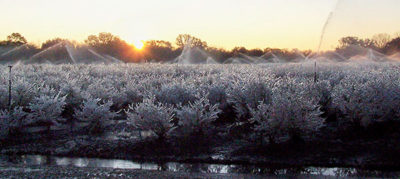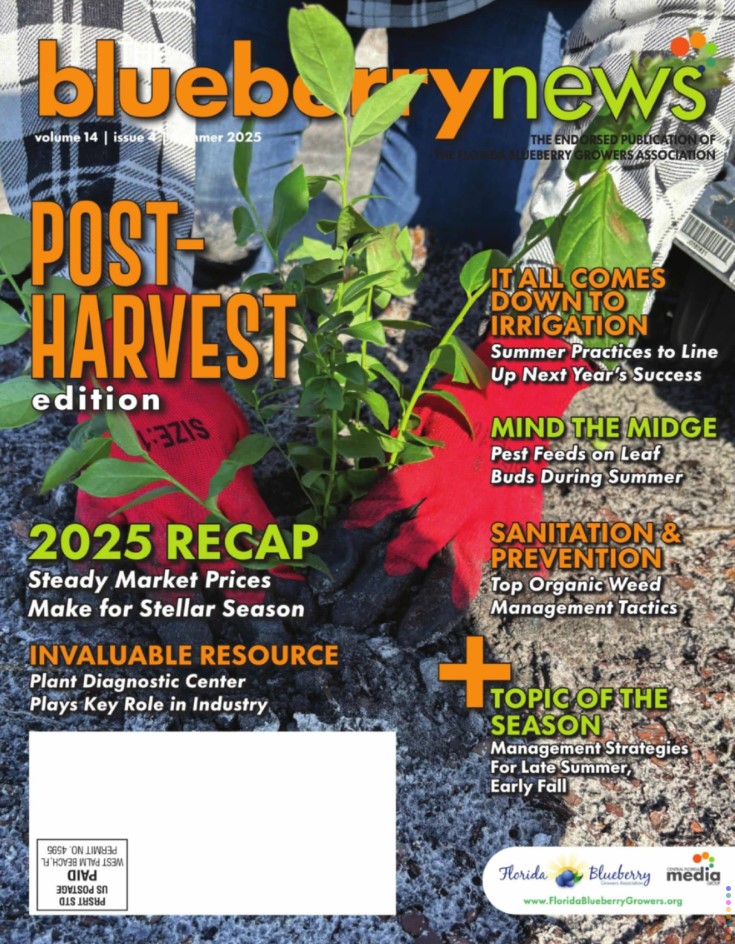Considering the Forecast, Field Conditions, Passive Freeze Protection, and Proper Irrigation System Operation
CLIMATE OUTLOOK
Over the past several blueberry seasons, growers have begun utilizing climatology for determining the overall weather trends they can expect during the winter and spring. A phenomenon known as the El Niño Southern Oscillation (ENSO) has been a main indicator of the overall weather pattern growers can expect.
ENSO affects surface water temperatures in the southern Pacific Ocean and the track of upper-level wind currents (jet stream) within North America. The location of the jet stream affects the tracks of weather systems as they move across the continent.
The Agroclimate website (agroclimate.org) provides excellent guidance on climate and tools growers can utilize for further information. Agroclimate lists the ENSO forecast for the three-month period. Currently, the ENSO forecast for the southeast is a 64 percent chance for the development of a La Niña climate phase.
During a La Niña, weather patterns in the southeast tend to be warmer and drier than normal. Other than a brief cool down in early December 2017, temperatures in most of Florida have been warmer than normal, and precipitation low.
Warmer temperatures associated with a La Niña do not necessarily mean an absence of freezes that could harm a developing blueberry crop. For this reason, growers need to be ready to protect their crops from freeze, should the threat of freezing temperatures occur.
EFFECTS OF FREEZE ON A DEVELOPING BLUEBERRY CROP
The stage of growth in your blueberry crop determines the probability of sub-freezing temperatures causing harm. During dormancy, blueberry plants can typically withstand temperatures below 20° F with no injury. As buds expand and develop, the critical temperature where damage can be expected to increase is through the 20s to about 31° F for plants with green fruit. A Michigan State University publication depicts critical temperatures for developing blueberry stages of growth. It should be noted that the critical temperatures included in this publication are for northern highbush blueberry cultivars and should only be utilized as a guide. Research establishing critical temperatures for southern highbush blueberry plants in Florida are now underway.
Since sub-freezing temperatures during blueberry fruit development are common throughout the winter and early spring, a majority of the commercial plantings within the state have overhead irrigation systems capable of protecting the crop from damage. Growers wishing to protect their blueberry crop from freeze with overhead irrigation will need a reliable freeze forecast and should consider passive freeze protection and proper irrigation system operation.
OBTAINING A RELIABLE FREEZE FORECAST
The UF/IFAS Extension Florida Automated Weather Network (FAWN) has the “Cold Protection Toolkit” containing numerous tools to aid in the evaluation of key weather data during freeze events. One of the tools called the “NWS Forecast - Interactive Map” will give the latest “NWS Pinpoint” forecast for locations of interest. The “Forecast Tracker” tool will show the accuracy of the forecast as a freeze progresses.
Other online resources such as the National Weather Service, Accuweather.com, Weatherunderground.com, and others provide various services. Some UF/IFAS Extension agents have Weather Watch Services that charge a fee for specialized forecasts generated by a retired NWS Meteorologist.
PASSIVE FREEZE PROTECTION TACTICS
➜ SITE SELECTION – A farm designed to achieve optimum cold air drainage is less susceptible to freeze, especially during calm wind conditions. Air drainage can also be facilitated by proper weed and vegetation control.
➜ CULTIVAR SELECTION – Growers may be able to lower the probability of dealing with freeze events by choosing blueberry cultivars that bloom later but still produce fruit in the optimum marketing window.
➜ DORMANCY – Practices such as managing fertility and soil moisture to allow the crop to enter dormancy at the proper time in the fall can make blueberry plants less susceptible to freeze damage.
➜ SOIL MOISTURE – Growers that irrigate their field the afternoon before an expected freeze event can experience 2° to 3° F higher temperature in their field versus a field with lower soil moisture and thus may possibly be able to reduce or even avoid running their irrigation system for freeze protection during the night.
OVERHEAD IRRIGATION FOR FREEZE PROTECTION
To protect your blueberry crop from freeze with an overhead irrigation system, there are several factors that should be considered to minimize the risk of damage while doing so:
➜ IRRIGATION SYSTEM DESIGN - The irrigation system should have a coefficient of uniformity of 80 percent or more. Many factors can affect this value and you should consult an irrigation design expert for further guidance. It is important to address any uniformity issues long before the threat of freeze is near. Many counties have access to FDACS funded Mobile Irrigation Labs (MIL) that will evaluate your system and make recommendations for increasing uniformity at little or no cost. You can find the MIL serving your county here.
➜ FREEZE TERMINOLOGY – to aid growers in assessing weather conditions related to freeze protection:
★ DEWPOINT TEMPERATURE is an indication of the moisture content of an air mass; the lower the dewpoint, the lower the moisture content of the air mass and the higher the potential for temperatures to drop.
★ WIND mixes the air, which tends to promote uniform temperatures in a field, while calm conditions often result in a temperature inversion where lowest temperatures are adjacent to the ground.
★ EVAPORATIVE COOLING or the reduction in temperature associated with the evaporation of water, increases when there is significant wind and the air is very dry (low dewpoint).
★ WET BULB is the temperature to which a plant surface will drop due to evaporative cooling when moisture, such as initial irrigation water, is introduced into a field. If wet bulb temperature in your field is less than the crop’s critical temperature, there is a possibility of crop damage if enough water to overcome evaporative cooling is not applied evenly to the field. Table 1 in a UF/IFAS Extension publication entitled “Protecting Blueberries from Freezes in Florida” demonstrates the effects of increasing wind at various irrigation system precipitation rates for overcoming evaporative cooling during freeze protection.
Typically, freezes consist of the advective (windy) phase during the first night or two followed by the radiation phase where wind is minimal or absent. During the advective portion of a particular freeze, it is vital to know if your irrigation system has a sufficient and uniform precipitation rate that will overcome evaporative cooling. During a radiation freeze with little to no wind and a clear sky, plant tissues will radiate heat and their temperatures may be slightly colder than air temperatures.
Due to inversion where the coldest temperatures are closest to the ground during a radiation freeze event, monitoring weather data, including wet bulb temperature will assist growers in determining the need to run overhead irrigation to protect their crop.
Having an understanding of crop stage of development, weather forecast, conditions in your field, and the capabilities of your irrigation system are vital to protect your crop from freeze.






